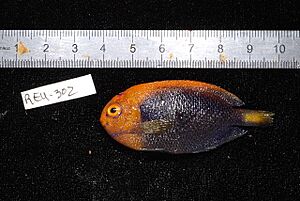Orangeback angelfish facts for kids
Quick facts for kids Orangeback angelfish |
|
|---|---|
 |
|
| A live individual. | |
 |
|
| A dead specimen. | |
| Conservation status | |
| Scientific classification | |
| Synonyms | |
|
The orangeback angelfish (Centropyge acanthops) is a beautiful and colorful fish that lives in the ocean. It's also known by other cool names like the flameback angelfish or African pygmy angelfish. In South Africa, people sometimes call it the Jumping Bean or just Bean because of how it moves! This fish is a type of marine angelfish and belongs to a family of fish called Pomacanthidae. You can find it swimming in the western part of the Indian Ocean.
What Does It Look Like?
The orangeback angelfish is quite striking! Its head, the top part of its body, its top fin (called the dorsal fin), and its tail fin (called the caudal fin) are all a bright golden yellow. But wait, there's more! The lower parts of its body and its bottom fin (called the anal fin) are black. These black areas are covered in many tiny, dense purple spots, making it look very fancy. If you look closely, you'll see that its eyes have a pretty blue ring around them. This fish is quite small, growing up to about 8 centimeters (or about 3 inches) long.
Where Does It Live?
This amazing fish calls the western Indian Ocean its home. You can find it swimming along the coast of East Africa, all the way from Somalia down to East London in South Africa. It also lives around islands like Madagascar, Seychelles, Comoros, the Chagos Islands, and the Mascarene Islands. On the Asian side, it has been seen in the Gulf of Aden and the Arabian Sea near Yemen (including Socotra) and Oman, as well as in the Maldives. It has even been spotted near the Cocos (Keeling) Islands, which are part of Australia.
Life and Habits
The orangeback angelfish likes to live in waters that are not too deep, usually between 1 and 70 meters (about 3 to 230 feet) below the surface. It often hangs out near coral reefs. You might also find it hiding among pieces of broken coral, which gives it a safe place to live. This fish loves areas where there's a lot of algae growing, because it eats algae and tiny invertebrates (small creatures without backbones).
These angelfish are quite social! They usually live in groups of up to 10 fish. They have a fascinating way of reproducing: they are what scientists call protogynous hermaphrodites. This means they can actually change their sex! In a group, the most dominant female can turn into a male. If that male loses its top spot, it can even change back into a female. When it's time to lay eggs, they do it at dusk (when the sun is setting). The male will gently bite the female's belly to encourage her to lay eggs. He then fertilizes the eggs, and they are left to float away in the ocean currents.
Why People Like Them
The orangeback angelfish is a very popular fish for aquariums. Many people enjoy keeping them in their home tanks because of their beautiful colors and interesting behavior. They have even been successfully bred in captivity, which means they can be raised in special fish farms rather than always being caught from the wild.


